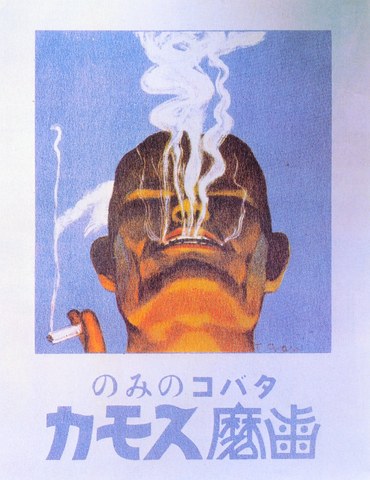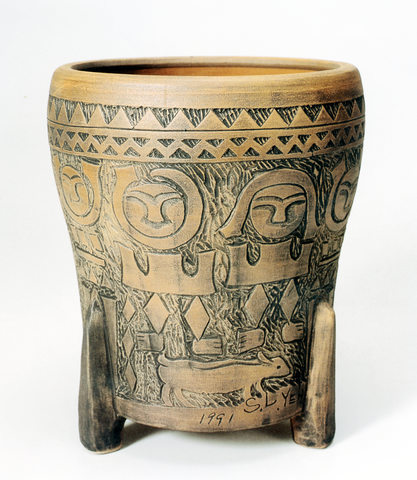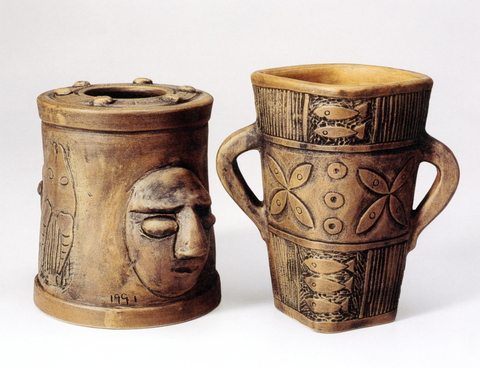Had Yan Shui-long (
Apart from being an outstanding oil painter, Yan devoted his life to handicrafts from his youth, trying several times -- though without success -- to set up his own handicraft school. He also wrote extensively on the subject in his later years.
Pioneer of Taiwanese Handicraft: special exhibition of Yan Shui-long's 100th anniversary, (

PHOTO COURTESY OF TAIPEI CRAFT DESIGN CENTER
To shed light on the life of a dedicated master, the exhibition also includes a reconstruction of Yan's studio, his collection of exotic handicrafts from other countries and some well-designed personal items like his glasses cases. Together, these create a rounded picture of an artist who lived out his art in his life.
Well-known as the "Father of Taiwanese handicraft," Yan juggled teaching, painting and making handicrafts. In preparation for a retrospective in 1997, which was meant to celebrate his 95th birthday, Yan painted eight hours a day in the hope of presenting an impeccable selection of works. He was tired out and slipped in his bathroom, sustaining a bone fracture. He soon died from complications resulting from an operation on the injury.
Throughout his life, Yan advocated the merits of handicrafts. "Art is not just a painting on the wall," Yan once said. Handicrafts not only help improve living standards in a developing country but foster people's appreciation of beauty, Yan said. They can give people a lift in a country that values wealth and longevity, because their influence on people are more far-reaching than fine art.

At a time when most artists in Taiwan would not demean themselves to make product designs or advertisements, Yan created many of these kinds of works. His series of 12 advertisements for Japan's Smoca tooth powder is the best part of the exhibition.
"Since freshening up after getting up in the morning is your style, how can you not use Smoca after smoking?" the advertisement asks in Japanese with a simple yet inviting picture of a bathroom door left ajar.
Yan's package designs for Taichung's Tai Yang Tang (

Rural life and Aboriginal culture inspired him most. Yan expressed his admiration for Aboriginal esthetics in his clay works. The stock imageries of snakes, fish and human figures are adjusted to depict the true life style of Aboriginal people.
Mural mosaics are another part of Yan's celebrated works. Apart from Rural Life mosaic in Taipei's Chian-tan Park and Sports in Taichung Stadium, the exhibition includes large pictures of many other mosaics which are located in less-visited places across the country.
"Pioneer of Taiwanese Handicraft," an exhibition celebrating Yan Shui-long's 100th anniversary will run until Oct. 26 at the National Taiwan Craft Research Institute's Taipei Craft Design Center, 9F, 20 Nanhai Rd, Taipei (

April 14 to April 20 In March 1947, Sising Katadrepan urged the government to drop the “high mountain people” (高山族) designation for Indigenous Taiwanese and refer to them as “Taiwan people” (台灣族). He considered the term derogatory, arguing that it made them sound like animals. The Taiwan Provincial Government agreed to stop using the term, stating that Indigenous Taiwanese suffered all sorts of discrimination and oppression under the Japanese and were forced to live in the mountains as outsiders to society. Now, under the new regime, they would be seen as equals, thus they should be henceforth

Last week, the the National Immigration Agency (NIA) told the legislature that more than 10,000 naturalized Taiwanese citizens from the People’s Republic of China (PRC) risked having their citizenship revoked if they failed to provide proof that they had renounced their Chinese household registration within the next three months. Renunciation is required under the Act Governing Relations Between the People of the Taiwan Area and the Mainland Area (臺灣地區與大陸地區人民關係條例), as amended in 2004, though it was only a legal requirement after 2000. Prior to that, it had been only an administrative requirement since the Nationality Act (國籍法) was established in

With over 80 works on display, this is Louise Bourgeois’ first solo show in Taiwan. Visitors are invited to traverse her world of love and hate, vengeance and acceptance, trauma and reconciliation. Dominating the entrance, the nine-foot-tall Crouching Spider (2003) greets visitors. The creature looms behind the glass facade, symbolic protector and gatekeeper to the intimate journey ahead. Bourgeois, best known for her giant spider sculptures, is one of the most influential artist of the twentieth century. Blending vulnerability and defiance through themes of sexuality, trauma and identity, her work reshaped the landscape of contemporary art with fearless honesty. “People are influenced by

The remains of this Japanese-era trail designed to protect the camphor industry make for a scenic day-hike, a fascinating overnight hike or a challenging multi-day adventure Maolin District (茂林) in Kaohsiung is well known for beautiful roadside scenery, waterfalls, the annual butterfly migration and indigenous culture. A lesser known but worthwhile destination here lies along the very top of the valley: the Liugui Security Path (六龜警備道). This relic of the Japanese era once isolated the Maolin valley from the outside world but now serves to draw tourists in. The path originally ran for about 50km, but not all of this trail is still easily walkable. The nicest section for a simple day hike is the heavily trafficked southern section above Maolin and Wanshan (萬山) villages. Remains of